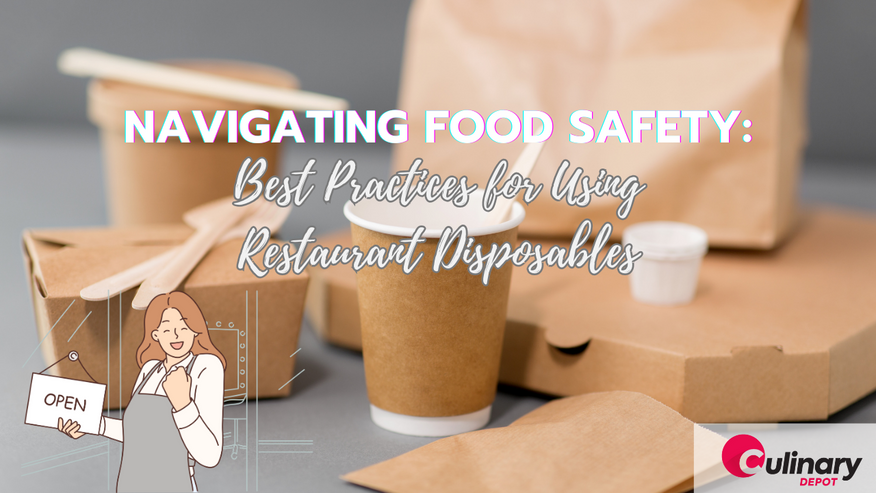Oct 17th 2023 - Team Member
Navigating Food Safety: Best Practices for Using Restaurant Disposables
Ensuring food safety is paramount in the fast-paced world of commercial kitchens and foodservice. One area where food safety often intersects with convenience is the use of restaurant disposables. Restaurant disposables can streamline operations, enhance customer experience, and maintain food safety standards when used correctly. However, to achieve these benefits, following best practices is crucial.
Maintaining Food Safety with Restaurant Disposables
The Importance of Food Safety

Customer Health
- Maintaining food safety is vital for the health and well-being of your customers.
- Foodborne illnesses can lead to significant legal and reputational consequences.
Compliance with Regulations
- Restaurants are subject to strict food safety regulations and standards.
- Non-compliance can result in penalties and closure.
Selecting the Right Restaurant Disposables

Material Matters
- Choose disposables made from food-grade, safe materials.
- Look for disposables certified by relevant authorities, such as the FDA.
Purpose-Driven Selection
- Select disposables that align with their intended use, e.g., choosing grease-resistant disposables for oily foods.
- Ensure disposables are compatible with hot and cold items.
Allergen Considerations
- Be aware of potential allergen cross-contact with disposables.
- Clearly label and segregate allergen-free disposables.
Storage and Handling
Proper Storage
- Store restaurant disposables in a clean, dry, and pest-free environment.
- Follow the manufacturer's recommendations for stacking and storage.
Hygienic Handling
- Train staff in the safe handling of disposables.
- Hands should be clean, and disposable gloves must be used when appropriate.
Reducing Cross-Contamination
Separate Usage
- Use separate disposables for raw and cooked foods.
- Avoid cross-contamination by clearly distinguishing between the two.
Barrier Use
- Utilize disposable barriers, such as wax paper, to protect disposables from direct contact with food.
- Prevent direct food-to-disposable contact.
Disposal and Recycling

Waste Management
- Establish a transparent waste management system for restaurant disposables.
- Use designated bins for disposables, ensuring proper disposal or recycling.
Biodegradable and Compostable Options
- Consider eco-friendly alternatives for disposables.
- If using biodegradable or compostable disposables, ensure they are disposed of correctly.
Employee Training
Ongoing Education
- Provide staff with continuous training on food safety measures.
- Include the proper use of disposables in training programs.
Compliance Checks
- Conduct regular compliance checks to ensure staff are following food safety protocols.
- Correct any deviations promptly.
Are takeout containers from restaurants safe to reuse?
Guidelines for Ensuring Food Safety
To ensure food safety, it is advisable to store restaurant leftovers or takeouts in the containers provided by the restaurant and refrigerate them promptly, following general guidelines such as not letting the food sit out for more than two hours. It is best to put it in the fridge as soon as you arrive home or after the leftovers have cooled.
Reusing Takeout Container
Restaurants and other food establishments use many kinds of takeaway containers. Before deciding whether to reuse a container, you must ascertain its material composition. Glass, cardboard, and polystyrene are simple materials to see and feel, while plastic is more difficult to identify.

- Glass: If the container is made of glass, it's safe to clean and reuse as long as it's in good condition without visible cracks or damage.
- Styrofoam and Cardboard: Avoid reusing Styrofoam and cardboard containers as they cannot be effectively cleaned and tend to disintegrate quickly.
- Polystyrene: Steer clear of polystyrene containers for storage. They tend to fragment easily and may leach styrene, the monomer used in their production. According to experts, they are not suitable for continuous use and heating.
- Plastic: When it comes to plastic containers, it's essential to determine the type of plastic used. Check the recycling symbol on the bottom of the container, which corresponds to the specific type of plastic. Consult resources like the Tufts University Plastics by the Numbers guide or refer to PBS for guidance on identifying the plastics you intend to reuse.
Remember that if you decide to reuse plastic containers, they should not be used for reheating food or cleaned in the dishwasher.
How long can containers be used without risk?
Glass containers that are in good condition can be reused. Discarding plastic takeaway containers once they look old or scratched is advised, even though there is no set rule for when to stop using them. In general, you should discard them after a few months to lower the possibility of bacterial growth or plastic leaching.
These containers will eventually become increasingly brittle, increasing the chance of microplastics flaking off and being consumed in your food. Furthermore, when these containers age, they become brittler, increasing the chance of microplastics falling off and contaminating your food.
If they are soiled or otherwise damaged, throw them away immediately.
Conclusion
Restaurant disposables are a valuable resource in commercial kitchens, enabling efficient service and reducing the risk of contamination. However, maintaining food safety requires diligence and adherence to best practices. It's not just a matter of serving food; it's about serving safe, high-quality meals that protect the health and well-being of your customers.
By selecting suitable disposables, handling and storing them correctly, reducing cross-contamination risks, and implementing rigorous staff training, you can confidently navigate food safety in your restaurant while enjoying the many benefits disposables provide.

